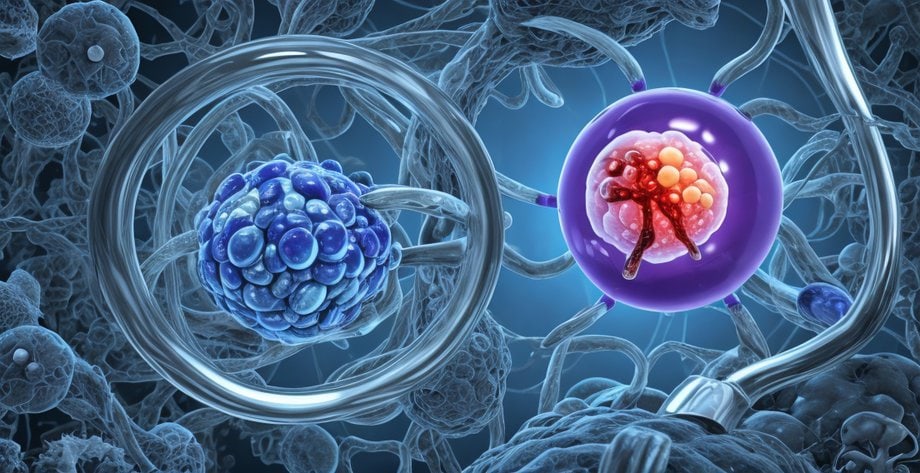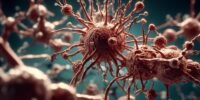Immunity Defense Mechanisms And Cells Explained

The immune system is a complex network of cells, tissues, and organs that work together to protect the body from harmful pathogens and foreign substances. This system plays a critical role in maintaining overall health and well-being, as it is responsible for identifying and neutralizing potentially harmful invaders that can cause diseases and infections.
As such, understanding the intricacies of the immune system and its defense mechanisms is essential for developing effective treatments and preventative measures against a range of illnesses.
In this article, we will explore the various types of immunity, including innate and adaptive immunity, and examine the different cells and molecules that are involved in the immune response. We will also discuss the functions of T cells, B cells, natural killer cells, phagocytes, and cytokines in immune responses, and how they work together to mount an effective defense against foreign invaders.
By the end of this article, readers will have a better understanding of how the immune system functions and the importance of maintaining a strong and healthy immune system for optimal health.
Key Takeaways
- The immune system is a complex network of cells, tissues, and organs that protect the body from harmful pathogens and foreign substances.
- There are two main types of immunity: innate and adaptive.
- Innate immunity is non-specific and provides rapid protection against a wide range of pathogens.
- Adaptive immunity is specific and develops over time in response to exposure to specific pathogens.
The Importance of the Immune System
The immune system plays a crucial role in protecting the body against pathogens and maintaining overall health and well-being. It is responsible for identifying and eliminating foreign invaders, such as bacteria, viruses, and fungi, that can cause infections and diseases. Without a properly functioning immune system, the body would be vulnerable to countless pathogenic attacks, leading to a host of health problems.
The immune system consists of various defense mechanisms, including physical barriers, such as skin and mucous membranes, as well as cells and molecules that work together to detect and destroy invading pathogens. These defense mechanisms can be categorized into two main types: innate immunity and adaptive immunity.
Innate immunity is the first line of defense and provides rapid, non-specific protection against a wide range of pathogens. Adaptive immunity, on the other hand, is more specific and develops over time in response to exposure to specific pathogens. Together, these mechanisms allow the immune system to recognize and respond to a wide range of pathogens, providing essential protection for overall health and well-being.
Types of Immunity
One way to categorize the body’s ability to fight off infections is by looking at the different types of responses it can mount. There are two main types of immunity: innate and adaptive.
Innate immunity is the body’s first line of defense against infections and pathogens. It is composed of physical barriers, such as skin and mucous membranes, and cellular and chemical components, such as natural killer cells and complement proteins. Innate immunity is non-specific, meaning it can recognize and respond to a wide range of pathogens without the need for prior exposure.
On the other hand, adaptive immunity is a specific response that develops after exposure to a specific pathogen. Adaptive immunity is characterized by the presence of memory cells, which allow the body to recognize and respond more effectively to a pathogen upon subsequent exposure.
There are two types of adaptive immunity: humoral and cell-mediated. Humoral immunity involves the production of antibodies by B cells, which can neutralize pathogens or flag them for destruction by other cells. Cell-mediated immunity, on the other hand, involves the activation of T cells, which can directly kill infected cells or activate other immune cells to do so.
Together, innate and adaptive immunity provide a robust defense against infections and diseases.
Innate Immunity
Innate immunity serves as the body’s initial barrier against various harmful pathogens and infections. This type of immunity is present at birth and is non-specific, meaning it responds to a wide range of pathogens without prior exposure. Innate immunity is composed of physical barriers, such as the skin and mucous membranes, and various cells and molecules that work together to prevent and control infections.
The table below summarizes the key components of innate immunity, their function, and examples of each component:
| Component | Function | Examples |
|---|---|---|
| Physical barriers | Prevent pathogen entry | Skin, mucous membranes |
| Phagocytes | Engulf and digest pathogens | Neutrophils, macrophages |
| Natural killer cells | Kill infected cells | Natural killer cells |
| Complement system | Enhance immune response | Complement proteins |
| Cytokines | Regulate immune response | Interferons, interleukins |
| Acute-phase proteins | Enhance immune response | C-reactive protein, fibrinogen |
Understanding the components of innate immunity is crucial for developing strategies to prevent and control infections. By working in tandem with adaptive immunity, innate immunity provides a multi-layered defense mechanism that helps protect the body from various harmful pathogens.
Adaptive Immunity
Adaptive immunity is a complex and highly specific defense mechanism that involves the recognition and targeting of specific pathogens. Unlike innate immunity, which provides a non-specific response to a wide range of pathogens, adaptive immunity targets a specific pathogen and develops a memory response to protect against future infections. This type of immunity is mediated by specialized cells called lymphocytes, which are produced in the bone marrow and mature in the thymus (T cells) or in the bone marrow (B cells).
The process of adaptive immunity begins when a pathogen enters the body and is recognized by specialized cells called antigen-presenting cells (APCs), which engulf and digest the pathogen. The APCs then display fragments of the pathogen on their surface, which are recognized by T cells. T cells then activate B cells, which produce antibodies that specifically target the pathogen. These antibodies can either neutralize the pathogen or mark it for destruction by other immune cells.
The development of adaptive immunity can take several days to weeks, but once established, the memory response can provide long-term protection against future infections.
Key Takeaways:
- Adaptive immunity is highly specific and targets a specific pathogen.
- Lymphocytes are specialized cells that mediate adaptive immunity.
- The process of adaptive immunity involves the recognition of pathogens by APCs, activation of T cells, and production of antibodies by B cells.
T Cells and B Cells
The differentiation and maturation of T cells and B cells occur in distinct anatomical locations within the body. T cells mature in the thymus gland, while B cells mature in bone marrow. These cells play important roles in the adaptive immune response, which is the body’s ability to recognize and respond to specific pathogens.
T cells, also known as T lymphocytes, are responsible for cell-mediated immunity. They recognize and destroy infected cells and cancer cells. There are several types of T cells, including helper T cells, cytotoxic T cells, and regulatory T cells. B cells, on the other hand, produce antibodies that can neutralize pathogens and mark them for destruction by other immune cells. The process of producing these antibodies is called the humoral immune response. Both T cells and B cells are essential for a functional adaptive immune system.
| T Cells | B Cells |
|---|---|
| Mature in the thymus gland | Mature in bone marrow |
| Responsible for cell-mediated immunity | Produce antibodies for the humoral immune response |
| Recognize and destroy infected cells and cancer cells | Neutralize pathogens and mark them for destruction |
| Types include helper T cells, cytotoxic T cells, and regulatory T cells | Essential for a functional adaptive immune system |
Natural Killer Cells
In our previous subtopic, we discussed T cells and B cells, which are important players in the immune system. However, there is another type of immune cell that is also crucial in fighting off infections and diseases: natural killer (NK) cells.
Unlike T and B cells, NK cells are part of the innate immune system and can quickly respond to infected or cancerous cells without prior exposure.
NK cells are named for their ability to kill target cells without the need for specific recognition. They are able to identify abnormal cells by looking for changes in the surface proteins of the cell. Once identified, NK cells release chemicals that trigger cell death and prevent the spread of the abnormal cells.
Additionally, NK cells can also produce cytokines, which are signaling molecules that help recruit other immune cells to the site of infection or inflammation.
Overall, NK cells play an important role in the immune system’s ability to recognize and eliminate abnormal cells, making them key players in our body’s defense against infections and cancer.
Phagocytes and Their Functions
Phagocytes, a type of immune cell, play a crucial role in recognizing and engulfing foreign particles and pathogens in the body. These cells are commonly found in blood and tissues and form the first line of defense against infections.
Phagocytes recognize pathogens through specific receptors on their surfaces that allow them to bind to various molecules present on the surface of the pathogen. Once bound, phagocytes engulf the pathogen and form a vesicle around it called a phagosome. The phagosome then fuses with lysosomes, organelles within the cell that contain enzymes capable of breaking down the pathogen into its constituent parts. These parts are then presented to other immune cells, which recognize and mount a specific response to the pathogen.
Phagocytes also play an important role in clearing up dead cells and cellular debris from the body. This function is crucial in maintaining tissue homeostasis and preventing damage from inflammation.
In addition, phagocytes are involved in antigen presentation, a process by which immune cells display fragments of pathogens on their surfaces to activate other immune cells. This process is essential for the adaptive immune response, which provides long-term immunity against specific pathogens.
Overall, phagocytes are an essential component of the immune system and play a critical role in protecting the body from infections and maintaining tissue homeostasis.
Cytokines and Chemokines in Immune Responses
Cytokines and chemokines are signaling molecules that play a crucial role in coordinating and regulating immune responses. These molecules are secreted by various cells, including phagocytes, T cells, and B cells, and they act on other immune cells to activate or suppress their functions. Cytokines are a diverse group of proteins that can be classified into different families based on their structural and functional properties. Some of the major cytokine families include interleukins, interferons, tumor necrosis factors, and chemokines.
Chemokines, on the other hand, are a subset of cytokines that specifically regulate the migration and activation of immune cells. They are named based on their ability to induce chemotaxis, which is the movement of cells toward or away from a chemical gradient. Chemokines are responsible for directing immune cells to the site of infection or tissue damage, where they can perform their functions. The table below summarizes some of the major cytokines and chemokines and their functions in the immune system.
| Cytokines | Functions |
|---|---|
| Interleukins | Regulate T cell proliferation and differentiation |
| Interferons | Inhibit viral replication and activate immune cells |
| Tumor necrosis factors | Induce cell death and inflammation |
| Chemokines | Regulate cell migration and activation |
| Transforming growth factor beta | Suppress immune responses and promote tissue repair |
Overall, cytokines and chemokines are essential for maintaining a balanced immune response. Their dysregulation can lead to various diseases, including autoimmune disorders, chronic inflammation, and cancer. Understanding the role of these molecules in immune regulation is crucial for developing effective therapies for various immune-related disorders.
Conclusion
The immune system plays a crucial role in protecting the body from harmful pathogens and diseases. There are two main types of immunity: innate and adaptive.
Innate immunity is the first line of defense and includes physical barriers, such as the skin and mucus membranes, as well as cells like neutrophils and macrophages.
Adaptive immunity is a more specialized response that involves T cells and B cells, which work together to recognize and destroy specific pathogens. T cells and B cells are key players in the adaptive immune response.
T cells are responsible for recognizing and attacking infected cells, while B cells produce antibodies that can neutralize pathogens. Natural killer cells are another important component of the immune system, as they can target and kill infected cells without needing prior exposure.
Phagocytes, such as neutrophils and macrophages, are also important for engulfing and destroying invading pathogens. Cytokines and chemokines are signaling molecules that help coordinate the immune response.
They can attract immune cells to the site of infection and activate them to destroy pathogens. Overall, the immune system is a complex network of cells and processes that work together to defend the body from harm.
In conclusion, the immune system is a vital component of the body’s defense mechanisms. It includes a diverse array of cells and processes that work together to protect against harmful pathogens and diseases. Understanding the different types of immunity, as well as the roles of T cells, B cells, natural killer cells, phagocytes, cytokines, and chemokines, is essential for developing effective treatments and vaccines for infectious diseases. Continued research into the immune system will undoubtedly lead to new insights and approaches for improving human health.








